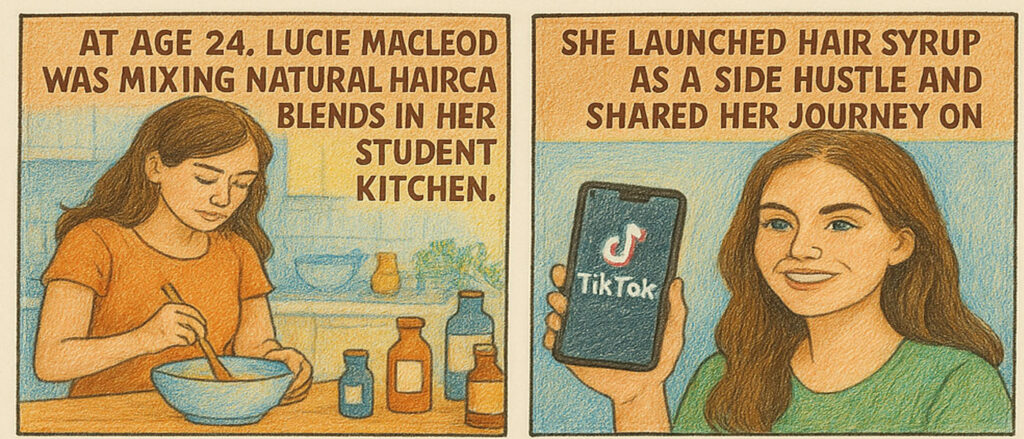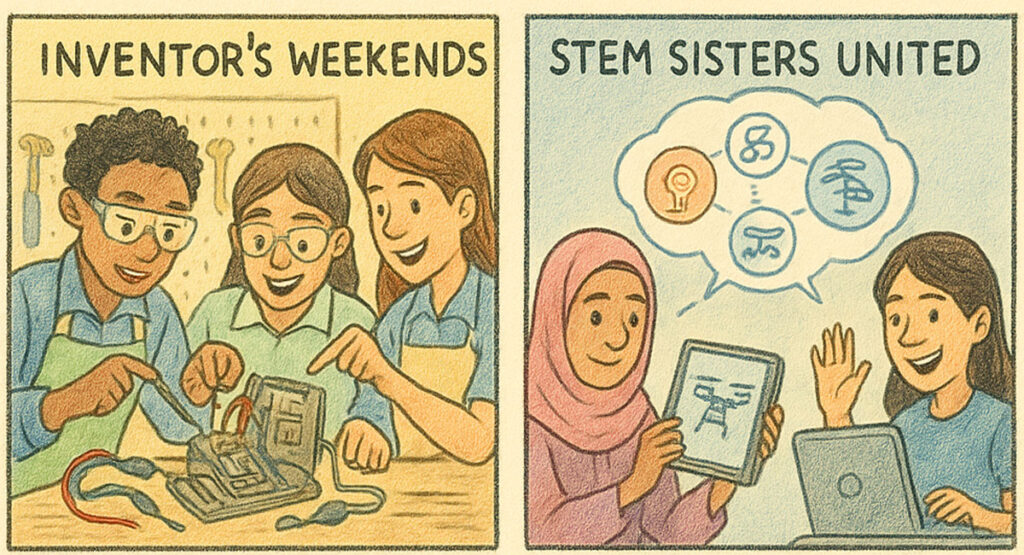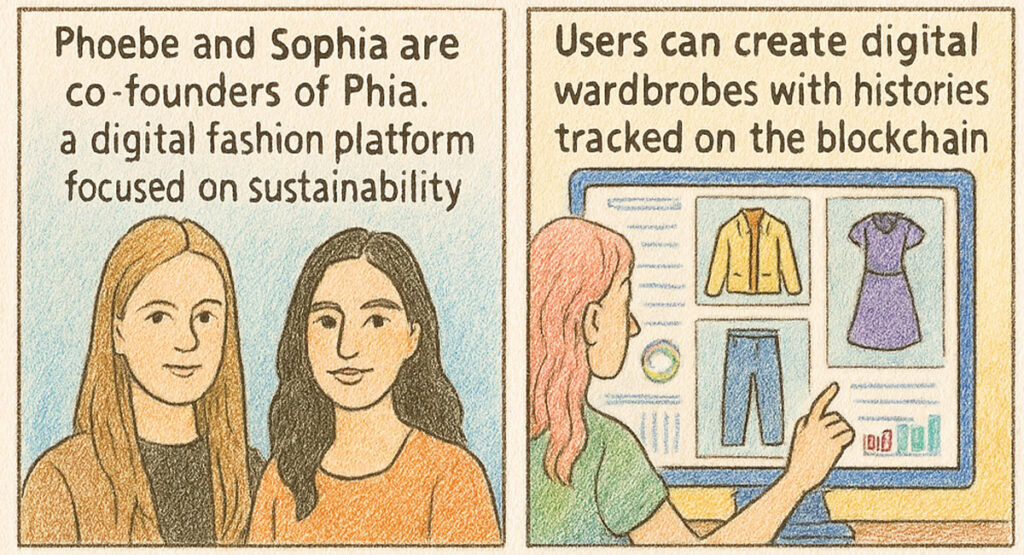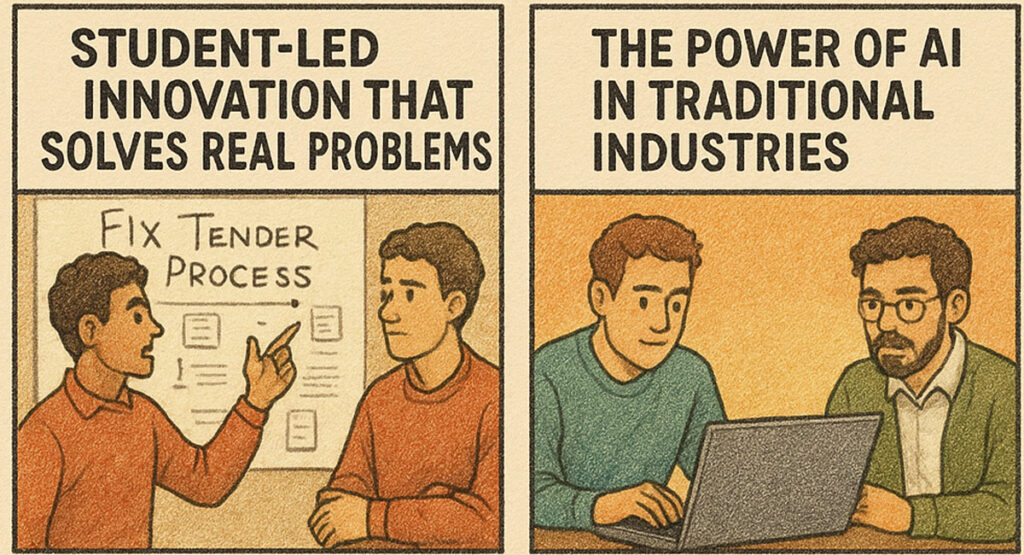“Threads of Memory: The Story of Evangelina Julia and Evade House”
In a quiet Madrid neighborhood bathed in golden afternoon light, there’s a studio filled with whispers of history, future, and fabric. Here, amidst reels of thread, wine-stained cotton, and seaweed-dyed silks, a young woman with a spark in her eyes is reimagining what fashion can mean. Her name is Evangelina Julia—a dreamer, designer, and the spirited founder of Evade House, a fashion label not only worn but felt, remembered, and even heard.
But to understand where Evade House began, we must travel back to another version of Evangelina: a girl born in 1994, in Madrid, to a family of doctors who wore white coats instead of couture. There, in the heart of the capital, Evangelina’s life was set to follow a well-trodden path—one that led to textbooks, laboratories, and biological formulas. She began her studies in biology, embracing the logic and order her parents valued. Yet, inside her, a quiet rebellion stirred.
Evangelina wasn’t just a scientist. She was also a model, stepping into the world of fashion with curiosity and a critical eye. The runways gave her a front-row seat to the industry’s glamor—but also its flaws. She saw opulence layered over exploitation, creativity constrained by commerce, and worst of all—waste. Mountains of unused fabric, fleeting trends devouring months of labor, and an eerie sameness across the racks.
This contradiction—a world so rich in texture, yet so poor in soul—began to gnaw at her. And so, with the clarity of someone who has seen both sides, Evangelina made a radical decision: to stop walking the runway and start shaping it.
In 2016, she moved to London—a city of fog and possibility—and enrolled at the London College of Fashion. There, she found her sanctuary. The curriculum wasn’t just about tailoring or textiles; it was about questioning the system, about seeing fashion as a vessel for emotion, for activism, for stories.
She soaked up zero-waste design philosophies. She experimented with felt, upcycled hosiery, and unconventional materials like mud and seaweed. While her peers stitched for trends, Evangelina stitched for touch, for memory, for meaning. She graduated in 2020 with a BA in Fashion Design and Development—armed not just with a degree, but with a vision.
That same year, as the world locked down and reflected inward, Evade House was born—not from commercial ambition, but from an aching need to connect. The debut collection wasn’t a shout for attention. It was a whisper in the dark, titled “Travelling Blind.”
The collection was a tribute to the visually impaired—those for whom fashion had remained a distant world. Garments featured braille labels, reversible structures, and textures designed to be explored by hand. Fashion, for once, was no longer just to be seen—but to be felt, worn with understanding. The garments became companions, stories woven into cloth.
From that point, Evangelina’s Madrid studio in Usera—once a humble workshop—turned into a crucible of alchemy. Fabrics were dyed with wine, coffee, and flowers; buttons were made from reclaimed metal, and every stitch carried a pulse. Her collections weren’t seasonal—they were emotional chapters.
In a 2022 project titled “Mud and Memory,” she incorporated soil-dyed fabric to represent how women across cultures have passed down traditions through work and earth. In another piece, inspired by the grief of losing a friend, she used layers of decaying cotton that softened with every wash, mimicking the healing of emotional wounds. She didn’t just create garments. She carved emotions into fabric.
Soon, whispers became echoes. Charli XCX wore her designs. So did Caroline Polachek, and Julia Fox, whose dramatic aesthetic perfectly fit Evangelina’s narrative fashion. But the fame didn’t sway her.
While fashion houses clamored for relevance, Evangelina dug deeper—into memory, community, and ethics. She partnered with Italian artist Laura Petrucci to launch Cartina Lunga, a sub-label that upcycled hosiery into surreal, sculptural wearables. That collaboration landed them at Milan Design Week, but Evangelina was still more excited about the dialogues it sparked than the spotlight it earned.
Awards came—Allianz EGO Confidence in Fashion, the NEO2 Best Fashion Designer prize—but Evangelina saw them not as trophies, but validations of a truth she always believed: fashion should be about humans, not just aesthetics.
Inside her studio, interns worked side-by-side with local seamstresses. Community workshops invited people to mend, share, and dye. The fabrics weren’t made in industrial vats; they were born in small batches, sometimes even on stovetops. She said it often, half-jokingly: “We’re not a fashion house. We’re a memory house.”
Her love for education led her to IE University, where she became a professor in the Bachelor of Fashion Design program. There, Evangelina didn’t just teach students to cut and sew—she taught them to listen. To question the cycle of overproduction, to embrace mistakes, to design for those who are unseen. She asked them, “If your garment could speak, what would it say?” Many of her students never forgot that question.
By 2025, Evade House had become a movement. Not mass-market, not Instagram-chasing, but something more rooted. Evangelina remained in Madrid, still walking to her studio, still hand-dyeing swatches, still dreaming up new sensory experiences. Her next project, she hinted, might involve sound-reactive fabric, blending fashion with music and memory.
“I want my clothes,” she once said, “to feel like your grandmother’s hands. Like the sea on your skin. Like the first time someone said your name with love.”
And in that, she succeeded.
Because Evade House was never just about clothes.
It was about healing.
About telling the stories fashion forgot.
And most of all, it was about a woman who dared to thread her own path—one touch, one tale, and one textile at a time.
🌿 The Ethos of Evade House: Fashion with a Conscience
Evade House operates with a clear and uncompromising mission:
🔹 Zero Waste: Every garment is created using reclaimed materials, natural dyes (from mud, wine, vegetables, and coffee grounds), and upcycled elements. Scraps are never discarded—they are reborn.
🔹 Limited Editions Only: There are no mass-produced items. Each piece is handmade by a small team of artisans and collaborators, resulting in intimate capsule collections.
🔹 Inclusive Design: The collections are designed for every body—regardless of ability, gender, or shape. Tactility, accessibility, and emotional resonance are sewn into every fiber.
🔹 Slow Fashion Philosophy: Evangelina rejects the tyranny of “Spring/Summer” and “Fall/Winter.” Instead, she designs when there is something to say, not when the calendar demands it.
🔹 Community-Driven: A portion of profits from select collections is invested in local workshops, artisan partnerships, and sustainability education programs.
🌟 From Local Workshop to Global Admiration
What started in a modest Usera studio quickly caught the attention of global artists. Evangelina’s one-of-a-kind designs were soon seen on Julia Fox, Charli XCX, Arca, and Caroline Polachek. But celebrity wasn’t the goal—it was a tool. A tool to amplify unheard voices and challenge traditional beauty.
Soon, industry accolades followed:
🏆 Allianz EGO Confidence in Fashion Award
🏆 NEO2 Fashion Award – Best Designer of the Year
🏆 Featured at Madrid Fashion Week and Milan Design Week
With the Italian creative Laura Petrucci, Evangelina co-founded Cartina Lunga, a sublabel exploring upcycled hosiery and sculptural fashion art, further deepening her brand’s narrative.
But rather than expand toward factories or fast growth, Evangelina did something radical: She kept things small. Personal. Human.
Evade House never hired PR firms or bought billboards. Instead, it built its reputation on quiet conviction. Its studio remains open to the public, where clients can touch fabrics, speak with artisans, and feel the stories unfold.
📈 Business With Purpose: The Numbers Behind the Philosophy
Though rooted in emotion and ethics, Evade House is also a thriving business model for the new generation of designers:
- Launched: 2020
- Headquarters: Madrid, Spain
- Team Size: ~10 core members + rotating artisan collaborators
- Sales Channels: Primarily through their official website, limited pop-ups, and curated concept stores in Spain, Italy, and Japan
- Annual Output: Fewer than 500 pieces per year
- Pricing Range: €120–€900 depending on complexity and materials
- Key Markets: Spain, France, Italy, UK, Japan, USA
- Revenue Model: Direct-to-consumer (DTC), grants, and sustainable art/fashion residencies
Evangelina also participates in fashion education networks, teaches as a professor at IE University, and mentors emerging designers. This diversified approach makes Evade House resilient, creative, and immune to trend fatigue.
🔮 What Comes Next: A Future of Healing Through Fabric
When asked what the future holds, Evangelina smiles with the quiet calm of someone who knows she’s walking her own road. She dreams of creating sensorial fashion installations, where garments react to sound, movement, and memory. She wants her next collections to explore themes like ancestral grief, migration, and the beauty of imperfection.
She also plans to launch Evade House Archive, a storytelling space where customers can share their own memories, which will then be transformed into custom garments. “We are all made of fabric,” she says. “And we carry our stains, our softness, our resilience.”
Her belief is simple: Fashion can be therapy. A way to stitch the soul back together.
✨ Final Words: A Revolution in Every Seam
Evangelina Julia is not just a designer. She is a memory-keeper, a disruptor, and a storyteller. In an age when fashion often feels disposable, she offers something sacred—meaning.
Through Evade House, she reminds us that we are not mannequins, but mosaics of emotion, and that clothing can hold the power to heal, protest, and remember.
As she once said to a group of students while holding a torn piece of wine-dyed cotton, “Don’t make fashion. Make feeling. Make something someone will never want to throw away.”
And that is exactly what she’s doing—one stitch, one memory, one revolution at a time.




















